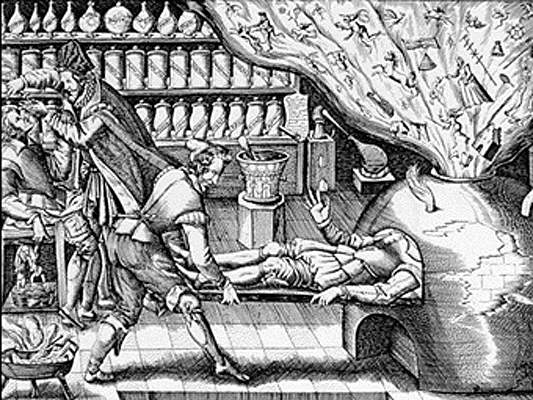
Before Hogwarts, before Ursula Le Guin’s school for wizards on Roke, did you know that a real academy that taught magic was proposed in Tudor England?
In about 1570, the courtier-explorer Humphrey Gilbert (the rather dishy, probably bisexual, half-brother of Walter Raleigh) proposed “the erection of an Academy in London for the education of her Majesty’s wards and other youth of nobility and gentlemen.”

It would teach the usual subjects, including rhetoric, humanities and letters, and practical subjects such as navigation and applied mathematics for fortification and gunnery.
It would also teach alchemy.
Alchemy was a serious subject at the time; well-educated people, including Elizabeth I herself and many of her high-ranking courtiers, invested money in it.
Alchemy had two main aims; to turn base metals into gold (usually gradually, so, for example, one might first turn iron into copper), and secondly, to make the philosopher’s stone. As fans of JK Rowling know, the philosopher’s stone is a substance that can prolong life and restore youth, but in Tudor times it also had a more cosmic purpose; once created, it would somehow restore the decaying world (which, even then, they thought was going to pot) and unite it politically and religiously under an Elizabethan Empire.
One of the teachers Gilbert had in mind for this proposed Academy was Dr John Dee.

Dee was a courtier, polymath and Catholic priest (he kept this last fact quiet sometimes, since Catholics weren’t always popular back then). He taught classics at Cambridge University, and mathematics at his home in Mortlake, near London. He wasn’t a qualified physician, but he had a good deal of medical knowledge and was called “Dr” as a result. He understood navigation and had advised Gilbert on a possible North-West passage to Cathay in 1567. They were friends, and by proposing the Academy, Gilbert may have been trying to find Dee a job.
Dee practiced alchemy, and a number of other disciplines that we – and his contemporaries – call magic. For example, he tried to summon spirits into crystals to question them about alchemy. He also thought one could tell the future by looking into polished surfaces to induce visions; he called this “optical science”.
To the modern mind, his writings are a strange blend of science, religion and superstition. He knew about practical iron-working, but also believed that some ideas were actually angels. He understood mathematics, but used his skills to solve devilishly complicated computations to tell horoscopes. He thought the movements of the planets could foretell political outcomes.
Gilbert gave his Academy proposal to Lord Robert Cecil, the queen’s advisor (and Master of the Queen’s Wards), but with running costs at an estimated £3,000 a year, Cecil must have decided it was too expensive.
So the Academy never eventuated.
But wouldn’t it be awesome if it had happened?
I like to imagine that it did – and that with his new-found freedom from the pressure to find patronage, Dee was able to branch out. He and his students would have set up vast alchemical laboratories, and explored new ways to summon spirits and divine the future.

I like to imagine they discovered some forms of magic that actually worked. Of course, they may also have discovered it wasn’t always the ‘youth of nobility’ who were the best magicians – in fact, it will turn out that most of the more successful magicians come from quite humble backgrounds…
The ‘Dee Institute’ (no longer just an Academy) is part of the back-story for Salt Magic Skin Magic, my m/m paranormal romance set in Yorkshire in 1851.
References
Exhibition materials at the Royal College of Physicians, Regents Park, London (18 Jan – 29 July 2016) Scholar, courtier, magician: the lost library of John Dee
Parry, G. (2011) The Arch-Conjuror of England: John Dee, Yale University Press. ISBN: 978-0-300-11719-6

Excellent article! Dr. Dee is a fascinating historical figure!
LikeLike
Thanks! He sure is!
LikeLike